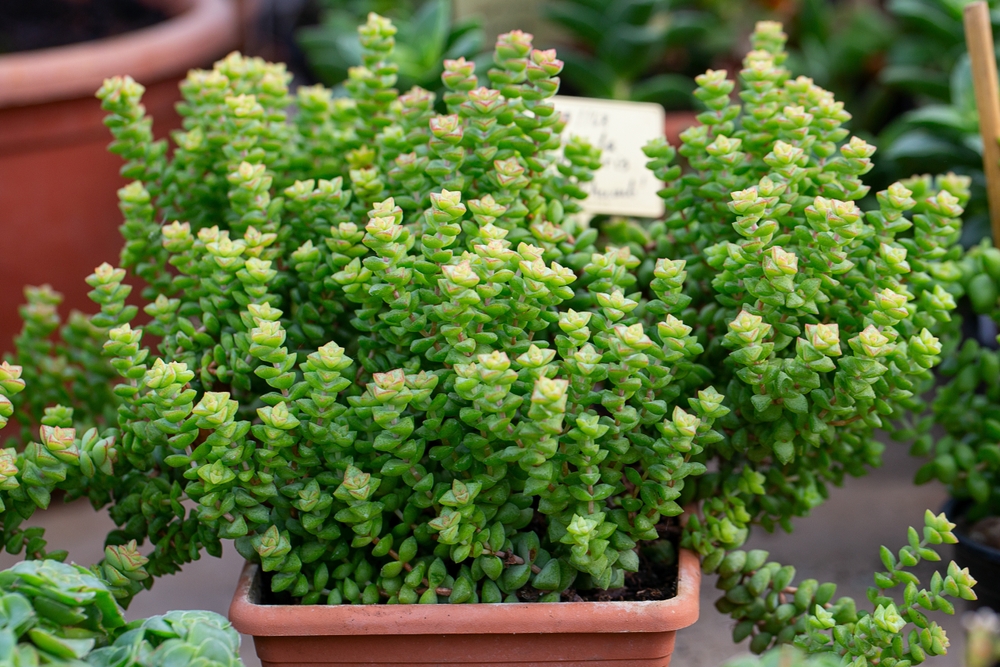
Baby’s necklace (Crassula rupestris) is a unique plant due to its stacked effect and small size, and caring for this beautiful plant is easy. Propagation can also be done quickly.
A baby’s necklace (Crassula rupestris) doesn’t need much care because it’s a hardy plant that can tolerate different weather conditions. However, keep an eye on the soil and apply water once it’s dry. Also, keep this plant in partial shade, especially on scorching days.
This article will discuss how to propagate a baby’s necklace plant in greater detail. It will also discuss critical care tips, so keep reading to learn more.
Baby Necklace Propagation Guide
Below is a guide on propagating Baby’s necklace (Crassula rupestris).
1. Take Cuttings
The first thing to do is examine the plant to see where you want to take the cuttings. If the baby’s necklace has multiple healthy stems and leaves, feel free to take more than one cutting (although this isn’t necessary).
Taking a cutting is simple – either use pruning shears to cut the stem at the bottom or use your hands and twist the stem until it comes off. For the cleanest cut and to minimize the chance of damage, use shears to make the cutting.
2. Use Rooting Hormone (Optional)
Rooting hormones aren’t entirely necessary, especially if you take a healthy cutting and plant it correctly in the appropriate soil. However, they can increase the chances of new root growth, so it doesn’t hurt to use some, if propagating a baby’s necklace.
Using rooting hormones is simple. All you need to do is place the end of the cuttings into the liquid or powder for a few seconds, ensuring you get enough product on the bottom. Once that’s done, you can move to planting your cutting.
3. Place the Cuttings in a Pot
Prepare a pot with well-draining soil before planting your propagated baby’s necklace stem(s). Additionally, ensure the pot has enough drainage holes so the water can escape easily.
While drainage holes on the bottom are critical, it’s also good to have some on the side for even better drainage.
The pot should be big enough for the cutting to grow healthy roots. If it’s too small, the cutting may eventually become rootbound, which you want to avoid.
4. Wait for the Roots To Form and Repot
It can take weeks for a baby’s necklace to form roots, so be patient. After 4 or 5 weeks have passed, pull it up to check for roots. If you think it needs more time to grow and develop, place it back in the soil and wait longer.
Once the roots have grown enough, it’s time to repot the plant into a larger container. This ensures the cutting has enough space to grow, promoting better airflow.
Caring for Baby’s Necklace
Now that you know how to propagate a baby’s necklace, let’s look at some of the most essential care tips.
1. Water the Plant Periodically
A baby’s necklace needs water to grow and thrive, so you’ll need to water the soil periodically. The watering schedule will depend on the time of year because more water is needed during the summer.
Most baby’s necklace plants do well with one deep watering every 1-2 weeks during summer. In winter you will only need to water it once every three weeks.
I recommend examining the soil before each watering. If it still feels slightly damp, give it more time, the soil should look or feel very dry before watering it again. Water it more frequently if the soil becomes completely dry within a few days.
2. Give the Plant Enough Sunlight (But Not Too Much)
As well as giving the plant enough water, it’s vital to provide it with the sunlight it needs to grow and remain healthy. Earlier, I mentioned that baby’s necklaces are hardy, which is true for the most part.
However, they are not entirely hardy when it comes to sunlight – too much heat from the sun can dry them out easily, causing plenty of problems.
Therefore, it’s best to avoid keeping them under direct sunlight at the hottest times of the day, like midday. While direct sunlight can be harmful, inadequate sunlight is also harmful, so don’t keep the plant out of the sun completely.
3. Make Sure the Soil and Pot Are Appropriate
The soil should be well-draining and contain all the vital nutrients a plant needs to grow and thrive. Nitrogen promotes healthy leaf growth while phosphorus supports root, stem and flower growth.
A commercial cactus mix or coarse, sandy soil can be mixed together with a ratio of 2:1 for a good draining mix, or you can make your own.
The baby’s necklace prefers shallow pots with drainage holes because they don’t tolerate sitting in water for lengthy periods of time. Look for a pot that is around 10% wider than the plant itself.
Conclusion
Baby’s necklace (Crassula rupestris) plants are beautiful and relatively easy to maintain and propagate. Make sure you follow these caring tips to ensure your baby’s necklace has the best chance to thrive and stay healthy and happy.
Other Articles You May Also Be Interested In
Crassula Capitella ‘Campfire Crassula’ Care and Propagation
Crassula Tetragona ‘Miniature Pine Trees’ Care and Propagation

